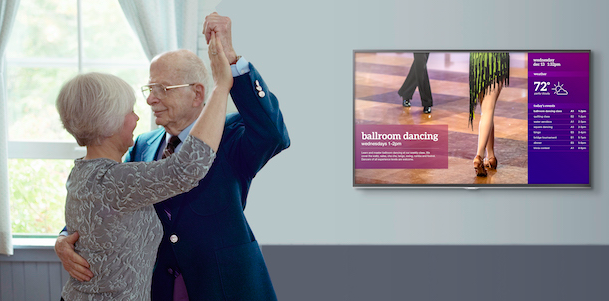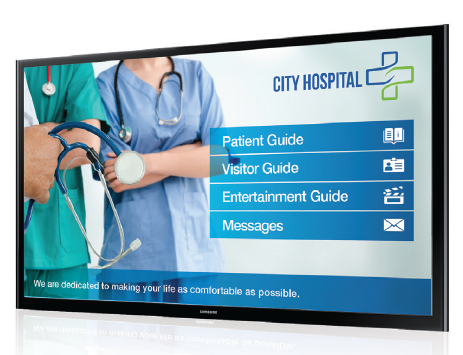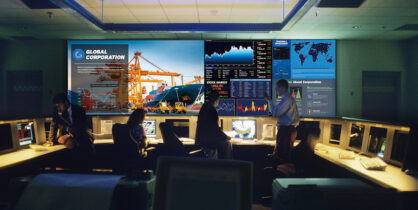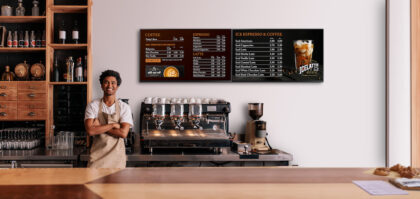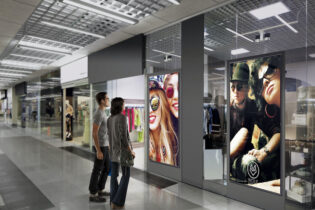Senior living facilities can vary widely in how they look and operate, but they all require information-sharing in order to foster a healthy community.
Whether they’re long-term care residences populated by people with physical or cognitive challenges, or hotel-like blocks for downsizing baby boomers, all senior living facilities have a consistent need to communicate effectively with staff and residents.
Digital signage and related technologies are particularly powerful tools for ensuring messaging is timely, visually engaging and tuned to the right audience.
Engaging residents
Digital displays are used in senior living environments as a highly visible means for making residents aware of what’s happening day to day, including any services available or upcoming schedule changes.
Optimize healthcare with digital signage
Learn how displays are easing pain points and transforming clinician and patient experiences. Download Now
Flat-panel displays — including touchscreens — make it easy to change information as often as needed, without final delay or added cost.
Here are some examples of how screens are used:
- Screens in gathering areas relay the range of daily activities being offered, from fitness and crafts to organized outings.
- Food services staffers use screens to display daily menu options, as well as special events and services.
- Digital calendars list upcoming events and activities, as well as information on registration and participation.
- Staff members also use screens to both welcome and introduce new residents — with personalized messages that can ease the lifestyle adjustment for seniors transitioning from independent living.
Inform staffers
The work demands vary, but a senior living facility is a busy place for employees. For long-term care facilities, many employees work around the clock.
The need for leadership to communicate quickly and effectively is important. This need has been amplified in 2020 by a global health crisis that puts seniors and their caregivers at heightened risk.
With staff on their feet throughout most of their care shifts, large, bright displays in key traffic areas ensure messaging is seen by people who don’t have time to sit down and read emails or notices on bulletin boards.
Screens also serve as a steady means of reinforcing health safety measures and encouraging workers who may need morale boosts and extra recognition, particularly during a pandemic.
Screens are used at nursing and other operational stations to relay everything from HR messaging to calls for colleagues to cover open shifts.
Digital signage dashboard displays can also work with real-time data from equipment and room sensors — as well as devices like smartwatches with health monitoring apps — to visualize the state of operations and report and signal anything from a missed meal delivery or cleaning to the significantly elevated heart rate of a resident, as reported by a smartwatch.
Sensors from systems such as access control can also be tied in, via data links, to signal if, for example, a resident with dementia has exited the building or a controlled area. Software and content can be instantly triggered for notification and to identify the doorway location.
Market to prospects
Just like hotels and condominiums, senior living facilities see regular turnover in their occupants, and that raises the need to market to future residents and, in some cases, to their extended families.
Digital signs in welcome areas greet, engage and inform prospective tenants, and interactive displays provide virtual tours and rundowns of the available services.
Interactive displays also help in presales discussions, showing room or suite availabilities as well as floor plans and features.
Operators can also use interactive displays to offer information in multiple languages, so that a prospective resident can get a full understanding of the facility and services in, for example, the Mandarin language — even if no one on the sales team speaks the language.
Multitasking communicators
Simple barriers like geographical distance can limit the contact senior living residents have with loved ones, and the challenge has been heightened in 2020 by lockdowns that prevent in-person visits to many facilities.
Digital displays have proven effective in bridging those gaps through technology, using digital signs and interactive whiteboards — like the Samsung Flip 2 — to double as video calling stations that connect seniors with family and friends. While smartphones and tablets are options, they’re small and potentially complicated. A 55-inch display, by comparison, gives residents a life-size view of the video callers and affords them the time to talk comfortably.
Screens that provide digital messaging can also easily double as tools for everything from slideshow presentations to singalong cues on karaoke nights. When visitor restrictions are in place for health reasons, video displays with remote call capability can virtually bring in entertainers and other guests.
Technology options
Busy facility operators need technology tools that are easy to learn, can be shared by multiple staffers and require only minutes of their precious time — not hours — to make changes or add new material.
Samsung has streamlined digital signage by building all of the hardware components needed inside the display — a plug-and-play system that’s available across a wide variety of display types and sizes. It also has mature content management software called MagicINFO that enables everything from content creation and scheduling to monitoring and troubleshooting. For example, by using MagicINFO, a senior living company with facilities dispersed across a region or around the country could manage all of its sites from the main office.
Helping happiness
Loved ones understandably worry about parents or close friends who are transitioning to senior living. A key to ensuring peace of mind for loved ones and optimal quality of life for residents is making sure the residents are engaged, active and happy. Putting in place the proper technology to effectively communicate a wide range of activities will drive the key return on investment — in happiness.
Find out more about the importance of digital signage in the healthcare landscape and why it matters for patients and clinicians alike in this free white paper. Discover more ways that senior care is benefiting from technology.
